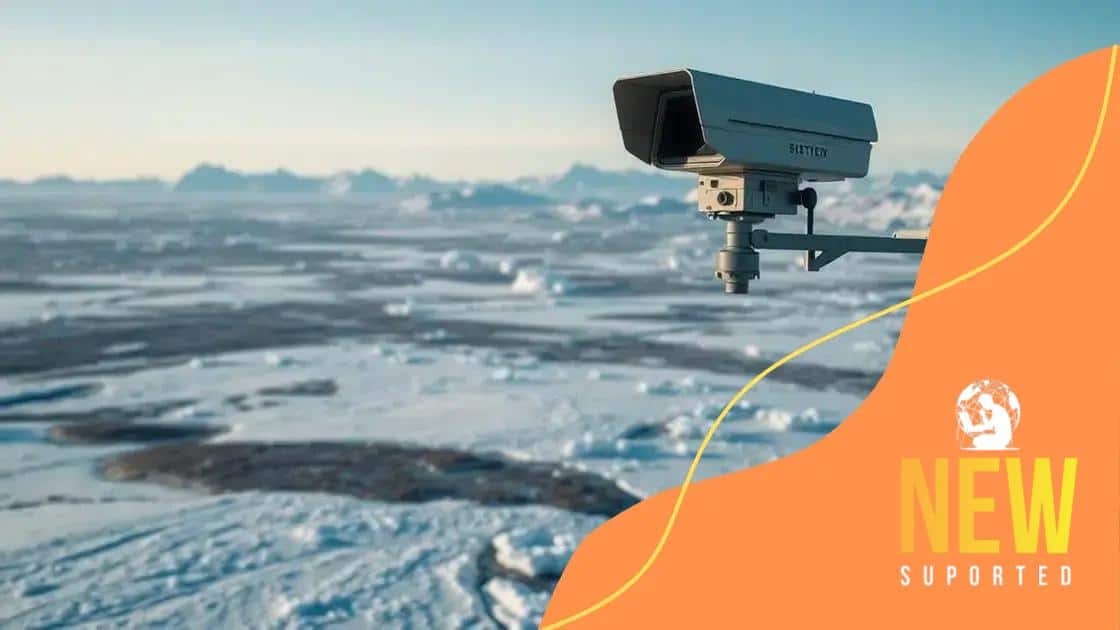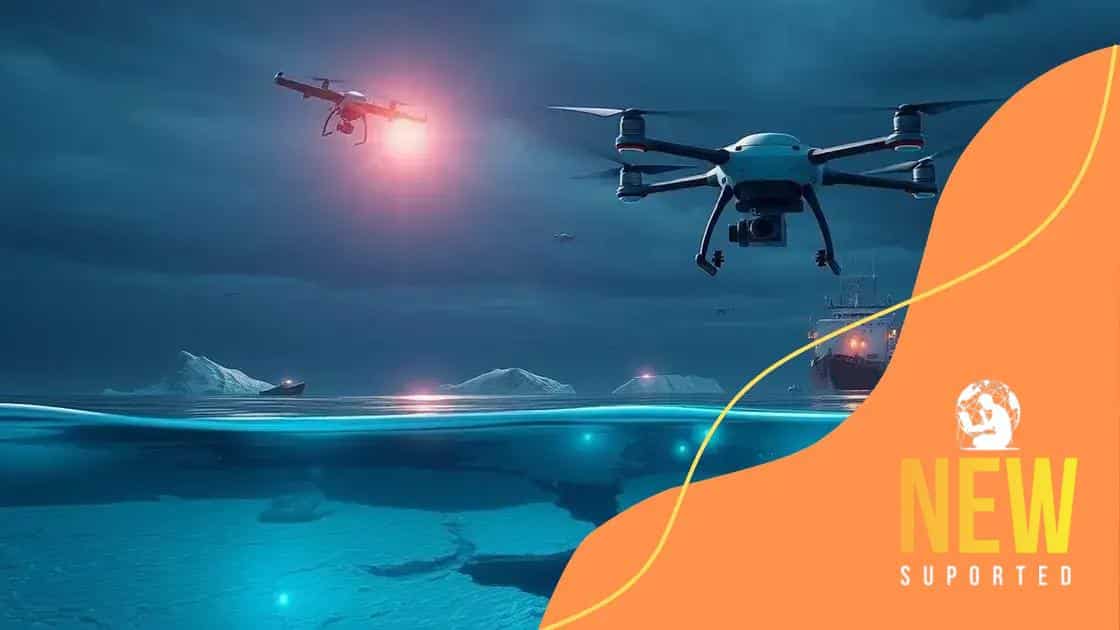US spy agencies Greenland surveillance tactics unveiled

US spy agencies conduct surveillance in Greenland to enhance national security, monitor climate change impacts, and secure interests in the increasingly strategic Arctic region.
US spy agencies Greenland surveillance has emerged as a hot topic as these agencies intensify their activities in the region. Why are they focusing on Greenland? Join me in exploring the motivations and implications behind this strategic move.
The historical context of surveillance in Greenland
Understanding the historical context of surveillance in Greenland helps to shed light on current strategies and motivations. Over the decades, Greenland has been a focal point for various geopolitical interests, primarily due to its strategic location in the Arctic.
Early Surveillance Efforts
Since World War II, the U.S. has had military bases in Greenland, most notably Thule Air Base. This base has been crucial for monitoring Soviet activities during the Cold War. However, the surveillance methods then were quite different from today’s advanced technologies.
Modern Developments
In recent years, with global warming affecting Arctic ice levels, there has been a renewed interest in Greenland. Governments are closely observing the melting ice caps, which can reveal natural resources. Furthermore, the region’s changing environment poses new security challenges.
- Increase in naval presence due to resource exploration.
- Collaboration between intelligence agencies for enhanced monitoring.
- Use of advanced satellite technology for real-time data.
The significance of Greenland, however, is not just tied to military interests. It also involves *diplomatic relationships* with Denmark and other Arctic nations. As the ice melts, new shipping routes are opening, making Greenland more pivotal in international trade.
In conclusion, the historical context of surveillance in Greenland reflects a complex interplay of military, environmental, and diplomatic factors. The surveillance that began as a defense strategy is evolving into a multifaceted approach addressing new global challenges.
Key US agencies involved in Greenland surveillance
Several US agencies play critical roles in conducting surveillance operations in Greenland. These agencies work together to gather intelligence and protect national interests in this strategically important region.
National Security Agency (NSA)
The NSA is primarily responsible for intercepting communications and gathering signals intelligence. The agency utilizes advanced technology to monitor satellite communications and electronic signals. This capability is essential given the growing number of international players interested in the Arctic.
Central Intelligence Agency (CIA)
The CIA focuses on gathering human intelligence and conducting covert operations. In Greenland, they work on understanding local dynamics and any shifts in geopolitical influences. Their presence helps the US maintain a strategic advantage.
- Monitoring of foreign military movements.
- Gathering intelligence on climate change effects.
- Assessing economic activities in the Arctic region.
Additionally, agencies like the Department of Defense (DoD) and the National Oceanic and Atmospheric Administration (NOAA) also contribute to surveillance efforts. The DoD manages military operations that involve tracking potential threats, while NOAA focuses on environmental changes that could impact national security.
The collaboration between these agencies enhances the US’s ability to respond to emerging challenges in Greenland. With Arctic ice melting, this region is becoming more contested. As a result, operational synergy is vital for effective surveillance and forecasting.
Technologies used for monitoring in the Arctic

The technologies used for monitoring in the Arctic have significantly evolved, enhancing the effectiveness of surveillance operations. These innovations play a key role in understanding environmental changes and potential security threats in this remote region.
Satellite Technology
One of the most important tools is satellite technology. Satellites provide real-time data on weather conditions, ice movements, and potential ship traffic. They allow agencies to monitor vast areas without the need for ground presence.
Unmanned Aerial Vehicles (UAVs)
UAVs, or drones, are increasingly used for reconnaissance. They can fly low and capture high-resolution images and videos. Drones are particularly useful in areas that are hard to reach due to ice or rough terrain.
- Gathering data on wildlife and ecosystem changes.
- Assessing ice thickness and tracking melting patterns.
- Monitoring shipping routes for safety and security.
Another crucial technology is underwater sensors. These sensors help track changes in ocean temperatures and ice melt, providing critical data for climate studies. The integration of various technologies allows for a comprehensive approach to Arctic monitoring, making it easier to identify and address emerging trends.
Moreover, data analytics and machine learning are changing how information is processed. These technologies can process large sets of data quickly, offering insights that can improve decision-making and response times in critical situations.
Implications for international relations and security
The implications for international relations and security in the Arctic region, particularly concerning Greenland, are profound. As various nations focus on this strategic area, the dynamics of global politics shift.
Increased Competition
Nations are vying for influence in the Arctic, leading to heightened competition. Countries like Russia, China, and the United States are all taking steps to assert their interests. This competition can lead to tensions. With melting ice revealing new shipping routes and resources, nations see Greenland as crucial for both economic and strategic reasons.
Collaboration vs. Conflict
While competition is on the rise, there’s also a push for collaboration. Many Arctic nations recognize the importance of working together to address climate change and its impacts. Cooperative efforts can lead to agreements on shipping regulations, resource sharing, and environmental protections.
- Joint military exercises to ensure stability.
- Multi-nation agreements on exploration and resource management.
- Establishing mechanisms to handle disputes amicably.
However, military presence is increasing, particularly from the US. This is necessary for ensuring security, yet it can also cause concerns among smaller Arctic nations. There is the risk that military build-up might lead to misunderstandings and potential conflict.
Furthermore, intelligence-gathering operations by U.S. agencies spark debates about sovereignty and the rights of local populations. Greenland’s residents may feel caught in the middle, navigating the pressures from large powers and their own aspirations for autonomy.
Public reaction and controversies surrounding surveillance
The public reaction and controversies surrounding surveillance activities in Greenland are significant topics of discussion. Many people are concerned about privacy, national security, and the potential for misuse of data.
Concerns Over Privacy
As surveillance increases, citizens often express worries about their privacy rights. Many believe that the presence of US spy agencies in Greenland could threaten personal freedoms. There are fears that increased monitoring might lead to intrusive practices, affecting not just national security but also everyday life.
Community Perspectives
Voices from local communities highlight diverse opinions. Some residents understand the need for surveillance, especially regarding climate changes impacting their livelihoods. However, others feel that they should be consulted about how these surveillance programs operate.
- Local communities demand transparency from government agencies.
- Calls for discussions about the balance between security and privacy.
- Concerns about the impact on Indigenous rights and land use.
Moreover, environmental groups raise issues related to how surveillance might affect Arctic ecosystems. They argue that increased military presence could have negative impacts on wildlife and natural habitats. This raises a complex ethical dilemma about prioritizing security over environmental conservation.
Media coverage also plays a role in shaping public opinion. Different outlets highlight various aspects, often focusing on the implications of surveillance not just for Greenland, but for global democracy. This leads to debates about how far countries can go in the name of protection.
FAQ – Questions about US Spy Agencies and Greenland Surveillance
What are the main reasons for US surveillance in Greenland?
The US conducts surveillance in Greenland primarily for national security, monitoring climate change effects, and safeguarding interests in the Arctic region.
How do local communities feel about the surveillance programs?
Local communities have mixed feelings; while some understand the need for security, many are concerned about privacy rights and the impact on their daily lives.
What technologies are utilized for Arctic monitoring?
Technologies include satellite systems for real-time data, drones for low-altitude reconnaissance, and underwater sensors for environmental monitoring.
How does international competition affect Arctic relations?
Increased competition among nations can lead to tensions, but it also encourages cooperation on climate issues and resource management in the Arctic.






